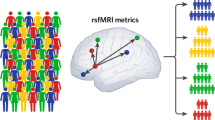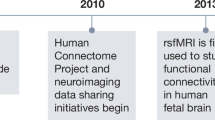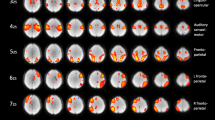Abstract
Little is known regarding the neuropsychological significance of resting state functional magnetic resonance imaging (rs-fMRI) activity early in the course of psychosis. Moreover, no studies have used different approaches for analysis of rs-fMRI activity and examined gray matter thickness in the same cohort. In this study, 41 patients experiencing a first-episode of psychosis (including N=17 who were antipsychotic drug-naive at the time of scanning) and 41 individually age- and sex-matched healthy volunteers completed rs-fMRI and structural MRI exams and neuropsychological assessments. We computed correlation matrices for 266 regions-of-interest across the brain to assess global connectivity. In addition, independent component analysis (ICA) was used to assess group differences in the expression of rs-fMRI activity within 20 predefined publicly available templates. Patients demonstrated lower overall rs-fMRI global connectivity compared with healthy volunteers without associated group differences in gray matter thickness assessed within the same regions-of-interest used in this analysis. Similarly, ICA revealed worse rs-fMRI expression scores across all 20 networks in patients compared with healthy volunteers, with posthoc analyses revealing significant (p<0.05; corrected) abnormalities within the caudate nucleus and planum temporale. Worse processing speed correlated significantly with overall lower global connectivity using the region-of-interest approach and lower expression scores within the planum temporale using ICA. Our findings implicate dysfunction in rs-fMRI activity in first-episode psychosis prior to extensive antipsychotic treatment using different analytic approaches (in the absence of concomitant gray matter structural differences) that predict processing speed.
Similar content being viewed by others
Log in or create a free account to read this content
Gain free access to this article, as well as selected content from this journal and more on nature.com
or
References
Aldrich E (2013). Wavelets: A package of functions for computing wavelet filters, wavelet transforms and multiresolution analyses. Available at http://cran.r-project.org/web/packages/wavelets/index.html.
Alonso-Solís A, Corripio I, de Castro-Manglano P, Duran-Sindreu S, Garcia-Garcia M, Proal E et al (2012). Altered default network resting state functional connectivity in patients with a first episode of psychosis. Schizophr Res 139: 13–18.
Anticevic A, Cole MW, Repovs G, Murray JD, Brumbaugh MS, Winkler AM et al (2014). Characterizing thalamo-cortical disturbances in schizophrenia and bipolar illness. Cereb Cortex 24: 3116–3130.
Argyelan M, Ikuta T, DeRosse P, Braga RJ, Burdick KE, John M et al (2014). Resting-state FMRI connectivity impairment in schizophrenia and bipolar disorder. Schizophr Bull 40: 100–110.
Bassett DS, Nelson BG, Mueller BA, Camchong J, Lim KO (2012). Altered resting state complexity in schizophrenia. Neuroimage 59: 2196–2207.
Biswal BB, Mennes M, Zuo X-N, Gohel S, Kelly C, Smith SM et al (2010). Toward discovery science of human brain function. Proc Natl Acad Sci USA 107: 4734–4739.
Brennan AM, Harris AWF, Williams LM (2013). Functional dysconnectivity in schizophrenia and its relationship to neural synchrony. Expert Rev Neurother 13: 755–765.
Butler PD, Schechter I, Zemon V, Schwartz SG, Greenstein VC, Gordon J et al (2001). Dysfunction of early-stage visual processing in schizophrenia. Am J Psychiatry 158: 1126–1133.
Carrión RE, McLaughlin D, Goldberg TE, Auther AM, Olsen RH, Olvet DM et al (2013). Prediction of functional outcome in individuals at clinical high risk for psychosis. JAMA Psychiatry 70: 1133–1142.
Cole DM, Oei NYL, Soeter RP, Both S, van Gerven JMA, Rombouts SARB et al (2013). Dopamine-dependent architecture of cortico-subcortical network connectivity. Cereb Cortex 23: 1509–1516.
Cole MW, Anticevic A, Repovs G, Barch D (2011). Variable global dysconnectivity and individual differences in schizophrenia. Biol Psychiatry 70: 43–50.
Dale AM, Fischl B, Sereno MI (1999). Cortical surface-based analysis. I. Segmentation and surface reconstruction. Neuroimage 9: 179–194.
Faber G, Smid HGOM, Van Gool AR, Wunderink L, Wiersma D, van den Bosch RJ (2011). Neurocognition and recovery in first episode psychosis. Psychiatry Res 188: 1–6.
Fischl B, Dale AM (2000). Measuring the thickness of the human cerebral cortex from magnetic resonance images. Proc Natl Acad Sci USA 97: 11050–11055.
Friston KJ, Frith CD (1995). Schizophrenia: a disconnection syndrome? Clin Neurosci 3: 89–97.
Grillon C, Ameli R, Charney DS, Krystal J, Braff D (1992). Startle gating deficits occur across prepulse intensities in schizophrenic patients. Biol Psychiatry 32: 939–943.
Guo W, Xiao C, Liu G, Wooderson SC, Zhang Z, Zhang J et al (2014a). Decreased resting-state interhemispheric coordination in first-episode, drug-naive paranoid schizophrenia. Prog Neuropsychopharmacol Biol Psychiatry 48: 14–19.
Guo W, Yao D, Jiang J, Su Q, Zhang Z, Zhang J et al (2014b). Abnormal default-mode network homogeneity in first-episode, drug-naive schizophrenia at rest. Prog Neuropsychopharmacol Biol Psychiatry 49: 16–20.
He H, Sui J, Yu Q, Turner JA, Ho B-C, Sponheim SR et al (2012). Altered small-world brain networks in schizophrenia patients during working memory performance. PLoS One 7: e38195.
He Z, Deng W, Li M, Chen Z, Jiang L, Wang Q et al (2013). Aberrant intrinsic brain activity and cognitive deficit in first-episode treatment-naive patients with schizophrenia. Psychol Med 43: 769–780.
Heinz A, Schlagenhauf F (2010). Dopaminergic dysfunction in schizophrenia: salience attribution revisited. Schizophr Bull 36: 472–485.
Hoptman MJ, Zuo X-N, Butler PD, Javitt DC, D’Angelo D, Mauro CJ et al (2010). Amplitude of low-frequency oscillations in schizophrenia: a resting state fMRI study. Schizophr Res 117: 13–20.
Hoptman MJ, Zuo X-N, D’Angelo D, Mauro CJ, Butler PD, Milham MP et al (2012). Decreased interhemispheric coordination in schizophrenia: a resting state fMRI study. Schizophr Res 141: 1–7.
Howes OD, Kapur S (2009). The dopamine hypothesis of schizophrenia: version III—the final common pathway. Schizophr Bull 35: 549–562.
Hutton C, Draganski B, Ashburner J, Weiskopf N (2009). A comparison between voxel-based cortical thickness and voxel-based morphometry in normal aging. Neuroimage 48: 371–380.
Javitt DC, Steinschneider M, Schroeder CE, Arezzo JC (1996). Role of cortical N-methyl-D-aspartate receptors in auditory sensory memory and mismatch negativity generation: implications for schizophrenia. Proc Natl Acad Sci USA 93: 11962–11967.
Kelleher I, Clarke MC, Rawdon C, Murphy J, Cannon M (2013). Neurocognition in the extended psychosis phenotype: performance of a community sample of adolescents with psychotic symptoms on the MATRICS neurocognitive battery. Schizophr Bull 39: 1018–1026.
Liang M, Zhou Y, Jiang T, Liu Z, Tian L, Liu H et al (2006). Widespread functional disconnectivity in schizophrenia with resting-state functional magnetic resonance imaging. Neuroreport 17: 209–213.
Liemburg EJ, Vercammen A, Ter Horst GJ, Curcic-Blake B, Knegtering H, Aleman A (2012). Abnormal connectivity between attentional, language and auditory networks in schizophrenia. Schizophr Res 135: 15–22.
Lin A, Wood SJ, Nelson B, Brewer WJ, Spiliotacopoulos D, Bruxner A et al (2011). Neurocognitive predictors of functional outcome two to 13 years after identification as ultra-high risk for psychosis. Schizophr Res 132: 1–7.
Liu H, Liu Z, Liang M, Hao Y, Tan L, Kuang F et al (2006). Decreased regional homogeneity in schizophrenia: a resting state functional magnetic resonance imaging study. Neuroreport 17: 19–22.
Lui S, Deng W, Huang X, Jiang L, Ma X, Chen H et al (2009). Association of cerebral deficits with clinical symptoms in antipsychotic-naive first-episode schizophrenia: an optimized voxel-based morphometry and resting state functional connectivity study. Am J Psychiatry 166: 196–205.
Lui S, Li T, Deng W, Jiang L, Wu Q, Tang H et al (2010). Short-term effects of antipsychotic treatment on cerebral function in drug-naive first-episode schizophrenia revealed by ‘resting state’ functional magnetic resonance imaging. Arch Gen Psychiatry 67: 783–792.
Lynall M-E, Bassett DS, Kerwin R, McKenna PJ, Kitzbichler M, Muller U et al (2010). Functional connectivity and brain networks in schizophrenia. J Neurosci 30: 9477–9487.
Ma X, Wang Q, Sham PC, Liu X, Rabe-Hesketh S, Sun X et al (2007). Neurocognitive deficits in first-episode schizophrenic patients and their first-degree relatives. Am J Med Genet Part B Neuropsychiatr Genet 144B: 407–416.
Mesholam-Gately RI, Giuliano AJ, Goff KP, Faraone SV, Seidman LJ (2009). Neurocognition in first-episode schizophrenia: a meta-analytic review. Neuropsychology 23: 315–336.
Notredame C, Pins D, Deneve S, Jardri R (2014). What visual illusions teach us about schizophrenia. Front Integr Neurosci 8: 63.
Orliac F, Naveau M, Joliot M, Delcroix N, Razafimandimby A, Brazo P et al (2013). Links among resting-state default-mode network, salience network, and symptomatology in schizophrenia. Schizophr Res 148: 74–80.
Overall J, Gorham D (1962). The brief psychiatric rating scale. Psychological Reports 10: 799–812.
Patriat R, Molloy EK, Meier TB, Kirk GR, Nair VA, Meyerand ME et al (2013). The effect of resting condition on resting-state fMRI reliability and consistency: a comparison between resting with eyes open, closed, and fixated. Neuroimage 78: 463–473.
Patterson JV, Hetrick WP, Boutros NN, Jin Y, Sandman C, Stern H et al (2008). P50 sensory gating ratios in schizophrenics and controls: a review and data analysis. Psychiatry Res 158: 226–247.
Percival D, Walden A (2000) Wavelet Methods for Time Series Analysis (Cambridge Series in Statistical and Probabilistic Mathematics). Cambridge University Press: New York, NY, USA.
Pettersson-Yeo W, Allen P, Benetti S, McGuire P, Mechelli A (2011). Dysconnectivity in schizophrenia: where are we now? Neurosci Biobehav Rev 35: 1110–1124.
Power JD, Cohen AL, Nelson SM, Wig GS, Barnes KA, Church JA et al (2011). Functional network organization of the human brain. Neuron 72: 665–678.
Ren W, Lui S, Deng W, Li F, Li M, Huang X et al (2013). Anatomical and functional brain abnormalities in drug-naive first-episode schizophrenia. Am J Psychiatry 170: 1308–1316.
Repovs G, Csernansky JG, Barch DM (2011). Brain network connectivity in individuals with schizophrenia and their siblings. Biol Psychiatry 69: 967–973.
Rodríguez-Sánchez JM, Crespo-Facorro B, González-Blanch C, Perez-Iglesias R, Vázquez-Barquero JL, PAFIP Group Study (2007). Cognitive dysfunction in first-episode psychosis: the processing speed hypothesis. Br J Psychiatry Suppl 51: s107–s110.
Roiser JP, Howes OD, Chaddock CA, Joyce EM, McGuire P (2013). Neural and behavioral correlates of aberrant salience in individuals at risk for psychosis. Schizophr Bull 39: 1328–1336.
Seidman LJ, Giuliano AJ, Meyer EC, Addington J, Cadenhead KS, Cannon TD et al (2010). Neuropsychology of the prodrome to psychosis in the NAPLS consortium: relationship to family history and conversion to psychosis. Arch Gen Psychiatry 67: 578–588.
Shepherd AM, Laurens KR, Matheson SL, Carr VJ, Green MJ (2012). Systematic meta-review and quality assessment of the structural brain alterations in schizophrenia. Neurosci Biobehav Rev 36: 1342–1356.
Takeuchi H, Taki Y, Hashizume H, Sassa Y, Nagase T, Nouchi R et al (2011). Effects of training of processing speed on neural systems. J Neurosci 31: 12139–12148.
Tankus A, Fried I (2012). Visuomotor coordination and motor representation by human temporal lobe neurons. J Cogn Neurosci 24: 600–610.
Turken A, Whitfield-Gabrieli S, Bammer R, Baldo JV, Dronkers NF, Gabrieli JDE (2008). Cognitive processing speed and the structure of white matter pathways: convergent evidence from normal variation and lesion studies. Neuroimage 42: 1032–1044.
Turner JA, Damaraju E, van Erp TGM, Mathalon DH, Ford JM, Voyvodic J et al (2013). A multi-site resting state fMRI study on the amplitude of low frequency fluctuations in schizophrenia. Front Neurosci 7: 137.
Umbricht D, Krljes S (2005). Mismatch negativity in schizophrenia: a meta-analysis. Schizophr Res 76: 1–23.
Vagharchakian L, Dehaene-Lambertz G, Pallier C, Dehaene S (2012). A temporal bottleneck in the language comprehension network. J Neurosci 32: 9089–9102.
Wang X, Xia M, Lai Y, Dai Z, Cao Q, Cheng Z et al (2014). Disrupted resting-state functional connectivity in minimally treated chronic schizophrenia. Schizophr Res 156: 150–156.
White T, Ehrlich S, Ho B-C, Manoach DS, Caprihan A, Schulz SC et al (2013). Spatial characteristics of white matter abnormalities in schizophrenia. Schizophr Bull 39: 1077–1086.
Woodward ND, Karbasforoushan H, Heckers S (2012). Thalamocortical dysconnectivity in schizophrenia. Am J Psychiatry 169: 1092–1099.
Xu P, Huang R, Wang J, Van Dam NT, Xie T, Dong Z et al (2014). Different topological organization of human brain functional networks with eyes open versus eyes closed. Neuroimage 90C: 246–255.
Yang GJ, Murray JD, Repovs G, Cole MW, Savic A, Glasser MF et al (2014). Altered global brain signal in schizophrenia. Proc Natl Acad Sci USA 111: 7438–7443.
Zhang D, Guo L, Hu X, Li K, Zhao Q, Liu T (2012). Increased cortico-subcortical functional connectivity in schizophrenia. Brain Imaging Behav 6: 27–35.
Zhou Y, Liang M, Tian L, Wang K, Hao Y, Liu H et al (2007). Functional disintegration in paranoid schizophrenia using resting-state fMRI. Schizophr Res 97: 194–205.
Acknowledgements
We appreciate the constructive comments of the anonymous reviewers in an earlier version of this manuscript.
Author information
Authors and Affiliations
Corresponding author
Additional information
Supplementary Information accompanies the paper on the Neuropsychopharmacology website
Supplementary information
Rights and permissions
About this article
Cite this article
Argyelan, M., Gallego, J., Robinson, D. et al. Abnormal Resting State fMRI Activity Predicts Processing Speed Deficits in First-Episode Psychosis. Neuropsychopharmacol 40, 1631–1639 (2015). https://doi.org/10.1038/npp.2015.7
Received:
Revised:
Accepted:
Published:
Issue date:
DOI: https://doi.org/10.1038/npp.2015.7
This article is cited by
-
Diagnosis of schizophrenia with functional connectome data: a graph-based convolutional neural network approach
BMC Neuroscience (2022)
-
Beyond noise to function: reframing the global brain activity and its dynamic topography
Communications Biology (2022)



